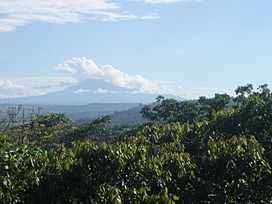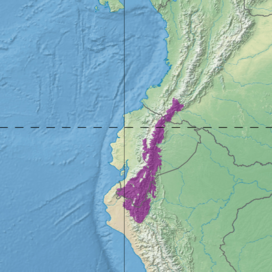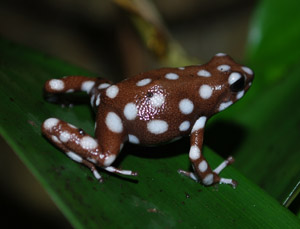Eastern Cordillera Real montane forests facts for kids
Quick facts for kids Eastern Cordillera Real montane forests (NT0121) |
|
|---|---|

|
|

Ecoregion territory (in purple)
|
|
| Ecology | |
| Realm | Neotropical |
| Biome | Tropical and subtropical moist broadleaf forests |
| Geography | |
| Area | 102,565 km2 (39,601 sq mi) |
| Countries | Colombia, Ecuador, Peru |
| Coordinates | 1°55′37″S 78°07′37″W / 1.927°S 78.127°W |
| Climate type | Aw (equatorial; winter dry) |
The Eastern Cordillera Real montane forests (NT0121) is a special natural area. It's found on the eastern side of the Andes mountains. This ecoregion stretches across parts of southern Colombia, Ecuador, and northern Peru.
Imagine forests that climb up the mountainsides. They start from the Amazon rainforest and go higher. As you go up, the trees change. You'll find cloud forests, which are often misty. Even higher, there are "elfin forests" with smaller, twisted trees. This area is full of amazing plants and animals. Many of these species are found nowhere else on Earth. Sadly, these forests are in danger. People are cutting down trees and clearing land for farms and cattle.
Contents
Geography of the Eastern Cordillera Real Forests
Where are These Forests Located?
These unique forests are on the eastern slopes of the central Andes mountains. They form a long, narrow strip. It's about 1,500 kilometers (930 miles) long. But it can be as narrow as 30 kilometers (19 miles) wide. This is because the forests only grow at certain mountain heights.
The ecoregion starts in the southern part of Colombia's Cordillera Oriental. It then goes through the eastern part of Ecuador's Cordillera Real. Finally, it reaches the northern Andes in Peru. The total area of these forests is huge, about 10.2 million hectares (25.2 million acres). That's like a very big country!
These forests touch other important natural areas. To the north, they meet the Magdalena Valley montane forests. To the east, they connect with the Napo moist forests. To the west, they border the Northwestern Andean montane forests. Higher up, they are next to cold, grassy areas called Northern Andean páramo.
What is the Land Like?
The land in this ecoregion is very rugged. It's made of mountains and hills on the eastern side of the Andes. The forests grow at heights from about 900 meters (3,000 feet) to over 2,100 meters (6,900 feet) above sea level.
In Peru, a small part of this forest even reaches the Pacific Ocean side. There's a special low point in the Andes called the Huancabamba Depression. It's about 2,000 meters (6,600 feet) high. This low pass is important for animals and plants moving between different areas.
The mountains to the south of this pass are older. They formed millions of years ago. The mountains to the north are younger. They formed more recently, within the last few million years.
On the Pacific side in Peru, the climate is drier. The forests there are smaller patches of trees. They have fewer types of plants and animals. But some species found there are unique to that spot. On the Amazon side, the forests get a lot of rain. This rain comes from moist air blowing in from the Amazon basin.
What is the Climate Like?
The Eastern Cordillera Real montane forests get a lot of rain. Typically, they receive 1,500 to 2,000 millimeters (59 to 79 inches) of rain each year. Some years, it can rain even more, up to 4,500 millimeters (177 inches)!
The climate here is called "Aw" by the Köppen climate system. This means it's an equatorial climate with a dry winter. The average temperatures are quite steady. They range from about 19°C (66°F) in July to 20.2°C (68.4°F) in April. The total rainfall for a year is around 2,400 millimeters (94 inches). The wettest month is usually March, and the driest is August.
Ecology of the Eastern Cordillera Real Forests
This ecoregion is part of the Neotropical realm. This is a large area that includes Central and South America. It's also part of the "tropical and subtropical moist broadleaf forests" biome. This means it's a warm, wet forest with many trees that keep their leaves all year.
The Eastern Cordillera Real forests are part of a bigger group called the Northern Andean Montane Forests. The Huancabamba Depression, that low pass we talked about, is very important. It allows different species to move between the Amazon and the Pacific lowlands. This mix of species makes the area very special. Many plants and animals found here are unique to this specific region.
Plants of the Forest (Flora)
The plants in these forests are mostly evergreen broadleaf trees. This means their leaves stay green all year. The types of plants change a lot depending on how high up the mountain you go.
In the lower parts, the forest is very dense and lush. It's called ceja de montaña, which means "eyebrow of the mountain." Higher up, the trees become shorter. Then you enter the cloud forest, which is often covered in mist. Even higher, you find elfin woodlands. These have small, gnarled trees. Many plant species are found only at certain heights. They can't easily move to other areas, so they become unique to their spot. Scientists believe these mountain forests might have once held 30,000 to 40,000 different plant species. That's even more than in the Amazon basin!
Animals of the Forest (Fauna)

These forests are home to many amazing animals.
Mammals
Some of the mammals you might find include the Venezuelan red howler monkey and the white-fronted capuchin monkey. There's also the rare yellow-tailed woolly monkey. A very special resident is the spectacled bear, the only bear found in South America. Other animals include the taruca (a type of deer), the guanaco (a wild relative of the llama), and the kinkajou. The shy mountain tapir might also live here. Sadly, some mammals are endangered. These include the equatorial dog-faced bat, the giant otter, and the white-bellied spider monkey.
Birds
The forests are a birdwatcher's paradise. You can spot colorful birds like the masked mountain tanager and the chestnut-bellied cotinga. There's also the tiny neblina metaltail hummingbird. The majestic Andean condor, one of the largest flying birds, soars above the peaks. Some birds here are endangered and found only in this region. These include the white-breasted parakeet, the coppery-chested jacamar, and the bicolored antvireo. Other endangered birds are the beautiful royal sunangel and the powerful black-and-chestnut eagle.

Reptiles and Amphibians
This ecoregion is home to many reptiles and amphibians. Some endangered reptiles include the Catamayo Coral Snake and the Lojan lancehead. Many types of frogs are also in danger here. These include various "stubfoot toads" like the Azuay stubfoot toad and the Boulenger's stubfoot toad. There are also "rocket frogs" and "marsupial frogs," which carry their young in a pouch. The colorful Marañón poison frog is another endangered amphibian found here. Many of these species are unique to these forests and need special protection.
Status of the Eastern Cordillera Real Forests
The World Wide Fund for Nature (WWF) says this region is "Vulnerable." This means it's at risk. The forests are quite easy to reach, which makes them more threatened. People are cutting down valuable trees like Podocarpus and Prumnopitys for wood.
Large parts of the original forest have been cleared. This land is used for grazing animals or for small farms. This loss of habitat is a big problem for the plants and animals that live there.
However, there are efforts to protect these special places. Some areas are protected, like the Cayambe Coca Ecological Reserve, Podocarpus National Park, and Noroeste Biosphere Reserve. These protected areas help save the unique wildlife and plants of the Eastern Cordillera Real montane forests.
Sources
See also
 In Spanish: Bosques montanos de la Cordillera Real oriental para niños
In Spanish: Bosques montanos de la Cordillera Real oriental para niños

